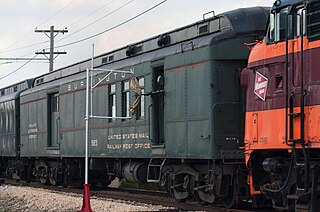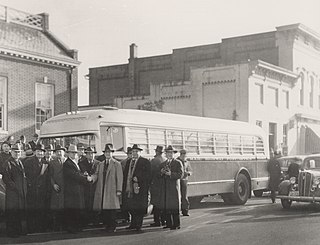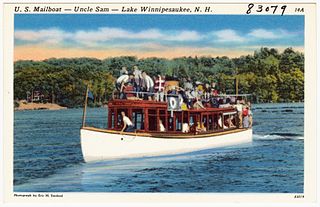The Railway Mail Service of the United States Post Office Department was a significant mail transportation service in the US from the mid-19th century until the mid-20th century. The RMS, or its successor the Postal Transportation Service (PTS), carried the vast majority of letters and packages mailed in the United States from the 1890s until the 1960s.

The United States Post Office Department was the predecessor of the United States Postal Service, in the form of a Cabinet department, officially from 1872 to 1971. It was headed by the postmaster general.

The Crescent is a daily long-distance passenger train operated by Amtrak in the eastern United States. It operates 1,377 miles (2,216 km) daily between Pennsylvania Station in New York City and Union Passenger Terminal in New Orleans as train numbers 19 and 20. Major service stops outside the Northeast Corridor include Birmingham, Ala.; Atlanta, Ga.; and Charlotte, N.C.

Saint Paul Union Depot is a historic railroad station and intermodal transit hub in the Lowertown neighborhood of the city of Saint Paul, Minnesota, United States. It serves light rail, intercity rail, intercity bus, and local bus services.

In Canada and the United States, a railway post office, commonly abbreviated as RPO, was a railroad car that was normally operated in passenger service as a means to sort mail en route, in order to speed delivery. The RPO was staffed by highly trained Railway Mail Service postal clerks, and was off-limits to the passengers on the train. In the UK and Ireland, the equivalent term was travelling post office (TPO).

A Travelling Post Office (TPO) was a type of mail train used in Great Britain and Ireland where the post was sorted en route.
The Federal Express was an overnight named passenger train run by the Pennsylvania Railroad and the New York, New Haven and Hartford Railroad between Washington, DC's Union Station and Boston, Massachusetts's South Station from 1912 to 1971. At different times, its route has taken it across the Hudson River via a car float between Port Morris and Jersey City, the Poughkeepsie Bridge, and finally the Pennsylvania Tunnel and Terminal Railroad. The final routing was identical to today's high-speed Northeast Corridor.
The Railway Mail Service (RMS) Library is a major collection of materials pertaining to en route distribution history. Incorporated in May 2003, it can assist researchers interested in Railway Mail Service, route agent, Seapost, Railway Post Office (RPO), and Highway Post Office (HPO) history. The collection has many unique, original-source documents that provide answers to questions dealing with the transportation and distribution of USA Mail between 1862 and 1977, as well as other countries during the 19th century and 20th century.

The term highway post office refers to brightly colored red, white and blue buses used to carry mail to multiple areas over wide distances.
An air mail facility is an installation for airmails of the United States.
Terminal railway post offices were sorting facilities which were established by the Railway Mail Service to speed the distribution of parcel post. These offices were usually located in or near railroad stations in major cities or junction points. Terminal railway post offices operated generally from 1913-1914 into the mid-1960s, before their function was absorbed by post office sectional centers.

From the 1880s until well into the 1950s, virtually all long-distance transportation of United States Mail was performed by the railroads. Specially equipped railway post office (RPO) cars were a part of most passenger trains, the cars staffed by highly trained railway postal clerks who sorted mail as the train sped along its route. The growth of this mail distribution network paralleled the expansion of the railroads, allowing mail to be exchanged between routes at junction points where two railroads crossed or shared passenger terminals.

Post was transported over water in the United States in the later nineteenth and the twentieth century.
Streetcar railway post office (RPO) routes operated in several major USA cities between the 1890s and 1920s. The final route was in Baltimore, Maryland. The Mobile Post Office Society, Affiliate 64 of the American Philatelic Society, has published monographs detailing the operational history of each route.
The Bureau of Transportation of the United States Post Office Department was established in 1960. It was the successor to the Postal Transportation Service (PTS); the PTS had responsibility for mail transportation contracting as well as employees assigned to Mobile Unit and stationary PTS facilities such as Air Mail Facility, Terminal Railway Post Office, or Transfer Office operations. Only the contract issuance and administration responsibilities for mail routes were given to the Bureau of Transportation. Human Resources were transferred to postmasters in the cities where Mobile and Stationary Units were located. This division of activity continued to the end of the Post Office Department and after it became the U.S. Postal Service.

Martin Luther King Jr. Plaza is the main passenger rail and intercity bus station of Toledo, Ohio.

The Metropolitan Special was the workhorse passenger train of the Baltimore and Ohio Railroad (B&O) during the 1920s–1960s between St. Louis, Missouri, and New York's Rockfeller Center station.

Mobile post offices deliver mail and other postal services through specially equipped vehicles, such as trucks and trains.

The Washington–Chicago Express, an American named passenger train of the Baltimore and Ohio Railroad (B&O), was one of four daily B&O trains operating between Washington, D.C., and Chicago, Illinois, via Pittsburgh, Pennsylvania during the 1930s–1960s. Other B&O trains of that period on the route were the Capitol Limited, Columbian, and the Shenandoah.
The Fast Mail was a Southern Railway mail and express train that operated between Washington, D.C. and New Orleans, Louisiana. The southbound Fast Mail carried the train number of 97, and was later known by the nickname of "Old 97". One such trip made by the train, on September 27, 1903, derailed at Stillhouse Trestle in Danville, Virginia, and was later known as the "Wreck of the Old 97", which the service was most well known for.











